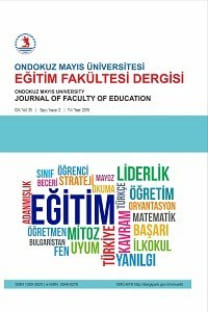Matematik ve Fen Eğitiminde Problem Kurma Uygulamaları
Problem Posing Practices in Mathematic and Science Education
___
- Abrams, J.; Honeyman, L. (2002). Teacher handbook, Mathematics research skills, http://www2.edc.org/makingmath/handbook/Teacher/ProblemPosing/ProblemPosing.pdf. (Erişim Tarihi: 28 Temmuz 2004).
- Ambrus, A. (1997). Problem posing in mathematics education, (Ed: Kansanen, P.), Discussions on Some Educational Issues VII. Research Reports, Helsinki, Finland, 5-19
- Borba, C.M. (1994). High school students’ mathematical problem posing: An exploratory study in the classroom. Annual Meeting of the American Educational Research Association, 24-28 April, New Orleans, USA.
- Brown, S.I., Walter, M.I. (1993). Problem posing, reflection and application, Lawrence Erlbaum Associate, Hillsdale, New Jersey, USA.
- Cai, J. (1997). An investigation of U.S. and Chinese students’ mathematical problem posing and problem solving, Annual Meeting of the American Educational Research Associatons, 24-28 March, Chicago, USA.
- Cai, J., Hwang, S. (2002). Generalized and generative thinking in US and Chinese students’ mathematical problem solving and problem posing, Journal of Mathematical Behavior, 21, 401-421.
- Charles, R., Lester, F., O’Daffer, P. (1997). How to evaluate progress in problem solving, NCTM, Inc., Sixth Printing, Reston, VA.
- Collier, C.P. (2000). Menu collection: Problems adapted from mathematics teaching in the middle school: National middle school association, National Council of Teachers of Mathematics, Ohio, USA.
- Daunt, B. (Çev: Kalkandelen, H.). (1997). Öğreticinin el kitabı, Pegem Yayıncılık, Ankara.
- El Sayed, R.A. (2001). Effectiveness of problem posing strategies on prospective mathematics teachers’ problem solving performance, The Mathematics Education into the 21st Century Project Proceedings of the International Conference New Ideas in Mathematics Education, Palm Cove 19-24 August, Australia. Enger, S.G., Yager, R.E. (1998). The Iowa assessment handbook, Science Education Center of The University of Iowa, USA.
- English, L.D. (1997a). The development of fifth-grade children’s problem posing abilities, Educational Studies in Mathematics, 34, 183-217.
- English, L.D. (1997b). Promoting a problem posing classroom, Teaching Children Mathematics, 3, 172-79.
- English, L.D. (2001). Problem posing research: answered and unanswered questions. Proceedings of the Annual Meeting of the North American Chapter of the International Group for the Psychology of Mathematics Education, Snowbird, Utah.
- Gonzales, N. A. (1994). Problem posing: a neglected component in mathematics courses for pro-service elementary and middle school teachers, School Science & Mathematics, 94(2), 78-84.
- Lavy, I.; Bershadsky, I. (2003). Problem posing via “what if not?” strategy in solid geometry - a case study. Journal of Mathematical Behavior, 22, 369–387.
- Lawrie, T., Whitland, J. (2000). Problem posing as a tool for learning, planning and assessment in the primary school, Ed: Nakahara, T., Koyama, M., Proceedings of the 24th Conference of the International Group for the Psychology of Mathematics Education, Hiroshima, Japan, 247-254.
- Lewis, T., Petrina, S., Hill, A.M. (1998). Problem posing-adding a creative increment to technological problem solving, Journal of Industrial Teacher Education, 36(1).
- Miller, C.M. (2000). Student-researched problem-solving strategies, Mathematics Teacher, 93(2), 136-138.
- Nakono, A., Murakami, N., Hirashima, T., Takeuchi, A. (2000). A learning environment for problem posing in simple arithmetical word problems, International Conference on Computers in Education/ International Conference on Computer Assisted Instruction (ICCE), 21-24 November, Taipei, Taiwan.
- Silver, E.A. (1995). The nature and use of open problems in mathematics education: Mathematical and pedagogical perspectives, International Reviews on Mathematics Education, 27(2), 67 –72.
- Silver, E.A. (1997). Fostering creativity through instruction rich in mathematical problem solving and problem posing, ZDM - Zentrallblatt fur Didaktik der Mathematik, 29(3), 75-80.
- Tuska, A. (2003). Attempts to improve the problem solving abilities of practicing teachers, The Mathematics Education into the 21st Century Project Proceedings of the International Conference, Brno, Czech Republic.
- Wilhelmus, C., Klaassen, M.K. (1995). A problem-posing approach to teaching the topic of radioactivity. Proefschrift Universiteit Utrecht, CD-ß Press, Utrecht.
- ISSN: 1300-302X
- Yayın Aralığı: 2
- Başlangıç: 1986
- Yayıncı: Ondokuz Mayıs Üniversitesi Eğitim Fakültesi
İlköğretim 8. Sınıf Öğrencilerinin Genetik ve Biyoteknoloji Konularına İlişkin Kavram Yanılgıları
Güzin AKAMCA ÖZYILMAZ, Hülya HAMURCU, Yasemin GÜNAY
Orta Öğretim Kurumlarının ve Özel Dersanelerin Kimya Öğretimine Yönelik Karşılaştırılması
Matematik ve Fen Eğitiminde Problem Kurma Uygulamaları
Matematik Eğitiminde Beklenen ve Gerçek Performans İlişkisi
Sinir Sisteminin Daha İyi Anlaşılması İçin Kavram Haritası Tekniğinin Kullanılması
